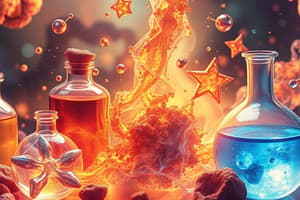Podcast
Questions and Answers
Which of the following is a characteristic of a homogeneous mixture?
Which of the following is a characteristic of a homogeneous mixture?
- It can be easily separated by physical means.
- It contains visibly different components.
- Its composition is uniform throughout. (correct)
- It has variable composition.
Which of the following identifies a non-metal?
Which of the following identifies a non-metal?
- Chlorine (Cl) (correct)
- Barium (Ba)
- Sodium (Na)
- Iron (Fe)
What type of compound can donate protons in a chemical reaction?
What type of compound can donate protons in a chemical reaction?
- Acid (correct)
- Base
- Neutral compound
- Salt
Which of the following best describes a colloid?
Which of the following best describes a colloid?
Which of the following is an example of a heterogeneous mixture?
Which of the following is an example of a heterogeneous mixture?
Flashcards are hidden until you start studying
Study Notes
Pure Substances and Mixtures
- Pure Substances: Composed of a single type of particle; have consistent properties throughout (e.g., elements and compounds).
- Mixtures: Combinations of two or more pure substances; properties can vary throughout the mixture.
Classification of Elements
- Metals: Typically solid (except mercury), good conductors of heat and electricity, and malleable. Examples include iron, copper, and gold.
- Non-Metals: Can be solid, liquid, or gas; poor conductors and often brittle. Examples are oxygen, sulfur, and bromine.
- Metalloids: Exhibit properties intermediate between metals and non-metals; semiconductors are important in electronics. Examples include silicon and arsenic.
Types of Compounds
- Acids: Substances that release hydrogen ions (H⁺) in solution; characterized by a sour taste and can conduct electricity. Examples include hydrochloric acid and sulfuric acid.
- Bases: Substances that release hydroxide ions (OH⁻) in solution; have a bitter taste and slippery feel. Common bases include sodium hydroxide and potassium hydroxide.
Homogeneous and Heterogeneous Mixtures
- Homogeneous Mixtures: Components are uniformly distributed; the mixture looks the same throughout and cannot be easily separated. Examples include saltwater and air.
- Heterogeneous Mixtures: Components can be seen and separated; the mixture has varying composition and properties. Examples include salad and sand.
Types of Mixtures
- Solutions: Mixtures where one substance is dissolved in another; they are homogeneous and transparent.
- Suspensions: Mixtures where particles are dispersed but not dissolved; they are heterogeneous and tend to settle over time. Examples include muddy water.
- Colloids: Mixtures with smaller particles that remain dispersed and do not settle; can appear homogeneous but scatter light. Examples include milk and fog.
Studying That Suits You
Use AI to generate personalized quizzes and flashcards to suit your learning preferences.




